The Wednesday before Easter, thanks to a press event for a
company I cover, I had my first chance since moving permanently to New York to go up the Empire State
Building Manhattan .
Looking south, it was clear how the forest canopy seemed to lower around
Greenwich Village, SoHo and the Lower East Side
into a less dense area of undergrowth or bush. It then rose again at the final,
dense clump in the Financial District, teetering on Manhattan ’s lower edge.
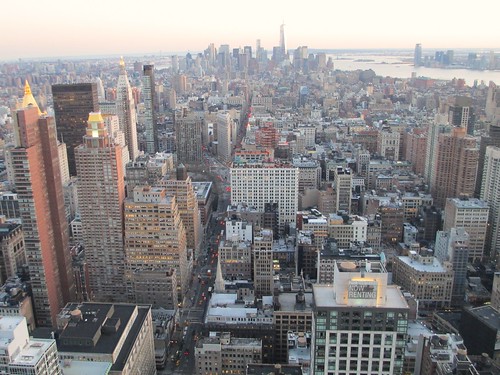 |
| The Greenwich Village dip, seen from the midtown jungle |
 |
| Midtown's skyscrapers: the lack of a "cyclists welcome" sign, I'd suggest, is no coincidence |
The view came to my mind the next day when I had to return
to midtown for a television appearance at Fox News’ studios on Sixth Avenue . I
rode up the Hudson River Greenway as far as 48th street . Then I started pedalling across town into the forest on which I’d been
looking down the night before. The deeper I cycled into the mid-skyscraper
canyon, the worse conditions became. I was constantly navigating around
jammed-up traffic and dodging sites where workers were fixing pipes and cables.
I was left wondering if, efficient though they can be, the densest parts of
very dense cities such as New York
are doomed to be fundamentally problematic places for human-powered transport.
The question’s relevant because many cities around the world
are trying to accommodate their expanding population not, as New York City did for much of the 20th century, by sprawling outwards, but by becoming
denser. There are calls for London
to build new, higher buildings to absorb its growth. There is a similar
movement in many parts of North America . It’s
easier, so the thinking goes, to serve dense cities with public transport,
since more journeys’ starting and end points can be an easy stroll from a
station or bus stop. Wouldn’t it be ironic, I thought to myself, if such a
movement – intended to make cities more environmentally friendly – made them worse for the bicycle, the most environmentally-friendly transport mode?
It’s certainly tempting as one grapples with the reality of
riding in midtown Manhattan
– as I used to every day before my office moved downtown – to flirt with the
idea that it’s a lost cause. The area crams into densities that in many cities
would be associated with slums and squalor a mixture of high-end housing and offices
teeming with some of the world’s best-paid professionals. No-one has the space
or inclination to undertake a vast range of everyday activities but most have
the money to pay to have them done. A stream of dry cleaners, express parcel
services and food delivery cyclists consequently flows to and from the area’s
offices and apartment complexes, giving the area the feel of being some vast apartment
hotel crossed with a serviced office.
Since many of the best-off people feel themselves too
important or fancy themselves in too much of a hurry to head into the subway,
taxis and limousines buzz constantly around the doorways. The business of supplying
food for the millions who swarm the area on a weekday would alone be enough to
create a substantial traffic jam. The same goes for the business of keeping the
people’s water, electricity, gas, sewage, hot water, internet, cable television
and other services running smoothly. Almost none of the people engaged in the
stressful business of meeting the area’s needs seems willing to take cyclists’
needs into account alongside the multiple other pressures they face. Cycling
can be a slow, stressful business of zig-zagging around double-parked delivery
vans, slipping past the edges of traffic jams and swerving to avoid the woman
who leaps into the cycle lane to hail a taxi.
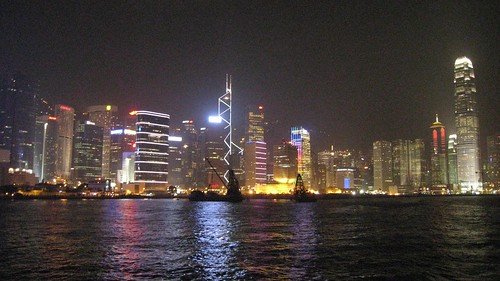 |
| Hong Kong wasn't built specifically to make people feel optimistic about cycling in midtown Manhattan. But it serves the purpose very well |
The intimidating atmosphere reminds me how I quailed, when
it looked as if I might get a job in Hong Kong ,
at the thought of cycling there. Hong Kong has twice New York ’s population density. I started to
wonder if it might be London ’s lower density –
half New York ’s
level – that makes it generally an easier (if still severely flawed) place to
cycle on-street.
Yet an incident later the day I appeared on Fox made me
ponder how far space and density really were the problem. I cycled after work
to Brooklyn to participate in a Maundy
Thursday church service and headed off home afterwards down Garfield Place in Park Slope. I sped down
the street, between rows of parked cars, at over 20mph, riding in the middle of
the lane for fear a still-faster car would try to pass me. Sure enough, after a
couple of blocks I noticed a Jeep Grand Cherokee close behind me, its driver
clearly trying to barge me out of the way. I found myself, not for the first time, terrified of being hit from behind if I made a mistake but fearful also
that, if I slowed down to pull out of the way, the driver would hit me before I was out of the way.
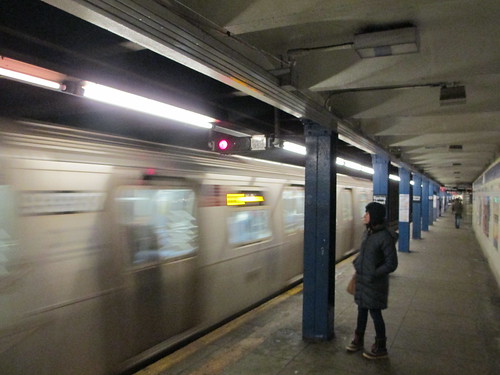 |
| The New York City subway: speed, packaged and hidden away |
When I factored speed into midtown conditions, I suddenly
saw them in a very different light. The problem wasn’t so much, I realised,
that there were so many delivery trucks and other commercial vehicles (although
it wouldn’t hurt to switch some of these deliveries to cargo bikes). The
problem was that those slow-moving vehicles had to stop every cross-town block
to accommodate lines of vehicles sweeping up and down the avenues. I suddenly
had a vision of a fast-moving taxi as taking up twice or three times its own
road space as one that was stationary. The genius of the New York subway and other urban metro systems
struck me. They take the problem of moving people fast – and consequently with
lots of space around their vehicles – pack the people into space-efficient
vehicles and bury the speed problem below the streets.
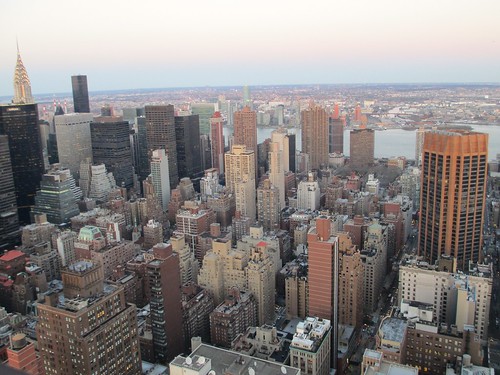 |
| Beyond midtown east, out stretches low-rise Queens |
The sheer unpleasantness of the world that way of living has
created came home to me this Saturday as I cycled to meet my family for a day
trip to the beach at Coney Island, on the edge of Brooklyn ’s
low-density sprawl. To cover the last stretch from a harbour-side cycle path to
the beach, the marked cycle route heads onto Cropsey Avenue , a terrifying six lanes of
suburban automotive culture full of vehicles seeking to drive at 40mph or
faster. Far from taking the lane to tame these barrelling lumps of high-speed
steel, I found myself letting my fear get the better of me. I
cowered - as I once did when cycling in Staten Island - in side streets at each intersection, waited for the herd of charging
cars to sweep past. Then I pedalled off after them as fast as I could, hoping to
outrun the next charge.At the corner of Cropsey Avenue Neptune Avenue -
 |
| It's invidious to claim one's city has the worst cycle facility anywhere. But is there a part of your city's cycle network quite as grim as Cropsey Avenue? |
It remains a stressful and forbidding experience to cycle in
the heart of midtown Manhattan
and in the densest parts of many other cities worldwide. Although I know
space-efficient bicycles have many advantages as a means of urban transport, I
don’t know precisely how I’d carve out space on the streets of midtown – or,
come to that, the City of London or Hong Kong – to encourage people less hardened than I to
cycle.
But, following Saturday’s experience, I feel confident on
one point. While W48th St Cropsey Avenue

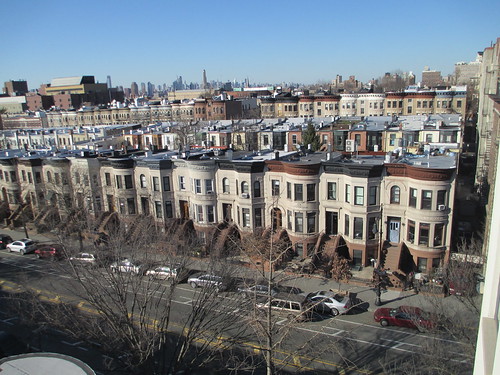
The most dense parts of many Japanese and European cities are either entirely car-free or have very few cars allowed in them. And as a result are very good for cycling and pedestrians.
ReplyDeleteA car-free Island of Manhattan makes a lot of sense and would work very well in making New York a far more pleasant and safe city for all its people.
Kevin,
DeleteMuch of Manhattan would indeed be better off without cars.
Unfortunately, I'm not sure the city is ready yet to consign to history all four free East River bridges, the Holland and Lincoln tunnels and all the other bits of motor vehicle infrastructure that run through Manhattan.
A pet project of mine - though even this I fear will be seen as impossible - would be to have all the Manhattan avenues made two-way again, as they once were. They'd feel far less like race tracks like that. But even that change would cost billions of dollars in re-engineering, traffic light replacement and so on. So I'm not sure it'll happen in my lifetime.
All the best,
Invisible.
Returning all the Manhattan Avenues to two-way traffic would be disastrous for buses, pedestrians and bikers. With one way avenues, you have the space for a dedicated bus lane and a protected bike lane. This would be impossible with two way traffic. Pedestrians would be faced with more cars making dangerous left turns across traffic while not looking to see if the crosswalk was clear. Crosstown bicyclists would have to deal with being even more alert looking for red light running cars in both directions, every block. Count me out. One way streets are much safer for all involved. The key is to engineer them to have safe, efficient and slow moving traffic for all parties.
DeleteAnonymous,
DeleteMy point of comparison is London, where pretty much no streets the width of the Manhattan avenues are one-way and where traffic speeds are much lower.
Sixth Avenue, for example, is six wide lanes across. Motorists using the middle lanes treat it as a race-track. There are also a lot of conflicting cross movements at cross streets, where motorists need to cross many lanes of traffic to reach their turning.
I would much prefer to see these streets turned into three lanes in each direction. Given the lanes' current width, I think there's ample room for a bike lane in each direction, a bus lane in each direction and two lanes of car traffic in each direction.
But, as I said above, the costs of changing the avenues' orientation would be so high that it will never happen.
All the best,
Invisible.
The people who must meet the stressful needs of the city do think also of you. However, because of the smaller number of stressed cyclists to be accommodated you are down the list of those who will be served.
ReplyDeleteTOM
Tom,
DeleteThanks for the comment.
This is, I suppose, one of those chicken-and-egg situations. If I could have persuaded, say, all my guests from the Fox News show to accompany back through midtown by bicycle and they'd persuaded all their chums, we might have created a sort-out business-y Critical Mass that would have made the cars think twice.
But, as long as I fail to organise such a thing, I'm fated to toil alone up 48th street, shouting at taxi drivers to look out, I suppose.
Invisible.
I hear many fellow cyclists who visit Europe come back with the "we must become Amsterdam" model for change. My instinct, though, tells me that Amsterdam was never the challenge NYC is in terms of population and traffic. At present, Amsterdam's population is less than 1 million. NYC's is 8.3 million. Every time I visit NYC, I admire your dedication to cycling even more. I wish I knew a way to change our big cities into cycling-friendly zones, but the sheer scale of the problem, particularly in NYC, defeats my imagination!
ReplyDeleteSouthLakes,
DeleteI shouldn't be too gloomy. The great thing about New York is it's hard in most of the city for cars to go quite as crazily fast as they do out in the suburbs. And it's tough commuting by every other means. The subway isn't straightforward fun and only a certifiable lunatic tries to make most journeys by motor car or taxi, in my opinion.
On top of that, we have the joys of experiencing one of the world's greatest cities up close. It's a thrill every morning to climb up over the East River and look at Manhattan spread before me.
So, yes, it will be a while before New Amsterdam has a cycling culture like Old Amsterdam's. But things are improving.
All the best,
Invisible.
Do you see congestion pricing as any part of the transportation solution for cities like New York? Intuitively, it appeals to me, but I can't claim I've thought it all the way through.
ReplyDeleteQMacrocarpa,
DeleteDo I see it as part of the solution? I see it pretty much as the solution.
There wasn't space to go into it in this post but I've written before about how the economics of transport in New York at present fundamentally misallocate resources: http://invisiblevisibleman.blogspot.com/2013/02/subway-fares-gas-tax-and-why-its-too.html Congestion makes a lot more sense when one understands it as queueing of the kind that used to be endemic in the Soviet Union's non-market economy.
I also wrote when I left London about how introduction of the Central London Congestion Charge marked the biggest single improvement to cycling conditions in my time there: http://invisiblevisibleman.blogspot.com/2012/09/farewell-to-london-where-cyclings.html
This is an area that crosses over into my work at my day job. I've just been working on a series about the US's infrastructure issues. You can see a video where I explain these issues - and interview "Gridlock" Sam Schwartz about congestion charging - here: http://video.ft.com/v/3504854003001
All the best,
Invisible.
Glad to hear a mention of Cropsey, which truly should not be orange on the cycling map.
ReplyDeleteIts much, much worse than your average terrible sharrow avenue (like 5th Ave in Sunset Park and Park Slope).
Its quite horrible because other than Cropsey theres almost a serviceable route along the entire waterfront from Bay Ridge to the Rockaways (if Neptune is good enough for you so basically confident cyclists only still).
I think i'll try Stillwell the next time i want to go to Coney Island by bike.
Brandon,
DeleteI don't particularly care for Neptune Avenue either, but it's not as bad as Cropsey and I have used it a couple of times to get from Coney Island to Sheepshead Bay.
It is, as you say, a pity. Once one's reached the Shore Greenway, it's pleasant, with spectacular views. It's such a pity it ends so abruptly and spills one onto such a dangerous street. Fifth Avenue in Park Slope is a complete breeze by comparison and far more manageable.
I rode back up Ocean Parkway. I don't like the intersections there because cars are apt not to yield to bikes in them. But it's far more manageable northbound because one's facing most of the turning traffic.
All the best,
Invisible.